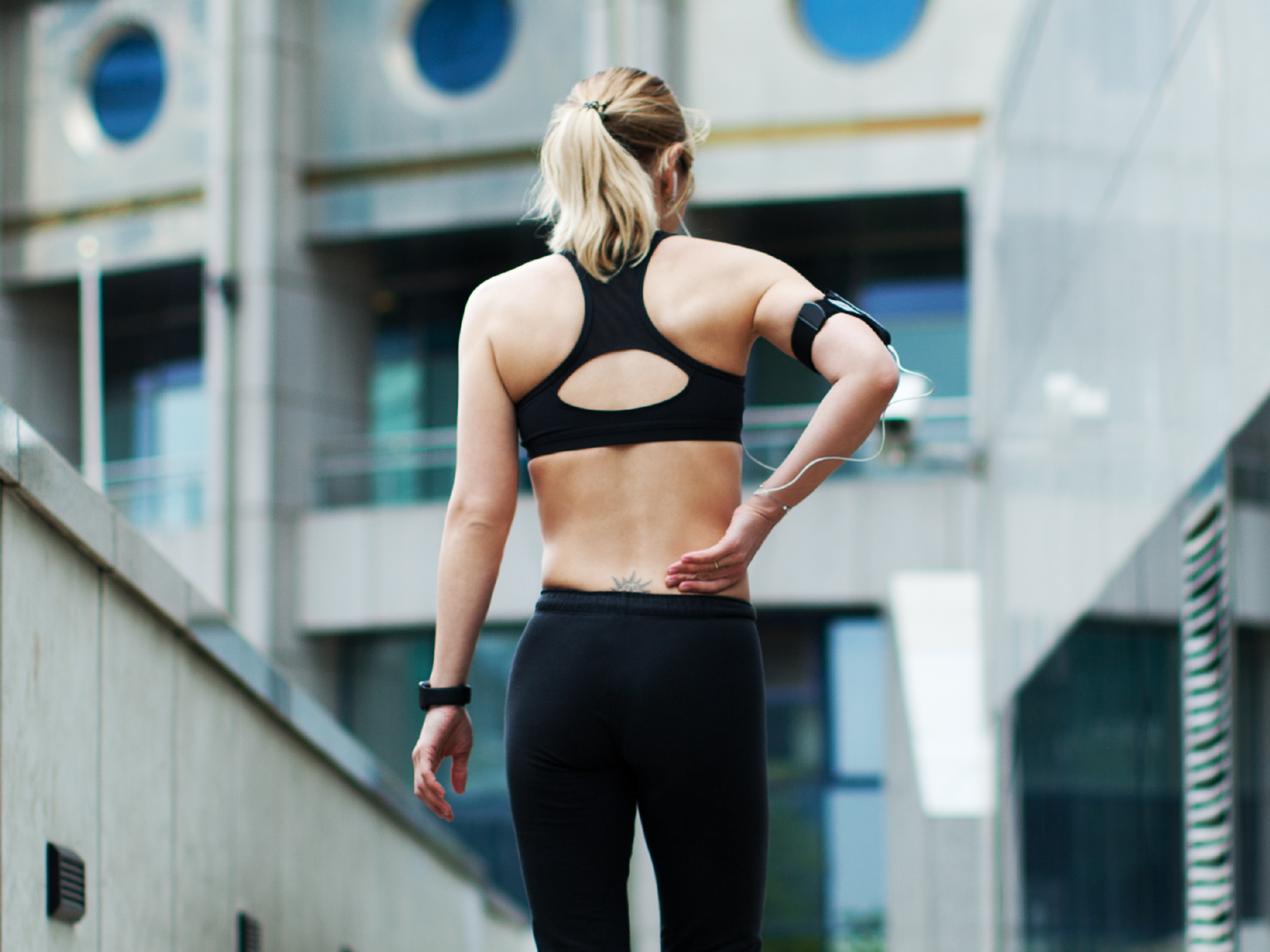How to treat lower back ache and 6 other common injuries
From lower back pain to shin splints, being injured can make movement difficult. So, we asked the experts how to ease pain from the most common injuries and when you should consult your GP.
There’s nothing like picking up an injury to stop your fitness journey in its tracks. Whether it’s lower back pain from sitting at your kitchen table for the past 18 months or shin splints from running in the wrong shoes, aches and pains make life and movement so much harder. But that doesn’t mean you can’t or shouldn’t do anything about it.
Leave twinges and aches for too long and you could find yourself dealing with a more serious problem. There are things you can do yourself to reduce pain and help injuries to heal. We called in the experts for their advice on how to treat the seven most common sports injuries from home.
You may also like
Stretching: Do these mobility exercises before every workout to avoid injury
1. Shin splints
If your shins are tender, especially when pressure is applied, you could have shin splints. Shin splints are caused by repetitive stress on the shinbone and connective tissues around it – think pounding the pavement on your evening run. Because they’re stress-related, the first thing you should do, according to Team GB soft tissue specialist James Hedger, is put your feet up.
“You need to offload them for a couple of days,” he says. “While you’re resting, it’s also a good idea to foam roll through the foot and the calf.” When the pain has subsided and you’re ready to get moving again, resume running on softer surfaces like grass and filter in some strengthening exercises. “Performing tibialis (toe) raises are a great way to strengthen your muscles to act as shock absorbers for the shin,” James says. “Doing plenty of single-leg balance work will also help control your foot on landing.”
Try:
- Having a rest for a week.
- Using a foam roller to massage the foot and calf muscles.
- Running on grass instead of concrete.
- Adding toe raises and single-leg work into your strengthening and conditioning sessions.
2. Lower back pain
A common lockdown combination of new fitness routines and DIY home workstations can be the perfect storm for aches, pains and strains in the lower back. Of the thousands of lower back injuries he has treated, Chris Klachan, a Canadian chiropractor and acupuncturist who has worked with medal-winning Winter Olympians, says that almost all have been caused or exacerbated by excessively tight hip flexors.
Chris explains: “Prolonged sitting and spikes in physical exercise can disrupt the delicate tension balance of the lower back. It’s known as lower cross syndrome.” A good place to start treatment, he advises, is with a hip flexor stretch.
- Start with the affected side’s knee on the ground, in a lunge position. From there, keep your torso upright and tuck the pelvis under (as if you’re trying to bring your tailbone to your nose). Gently push the hips forward into an extended position, and squeeze your glutes. Hold for 20 seconds.
- Next, reach the same side hand up and towards the ceiling and hold that for 20 seconds.
- Finally, lean away from the stretch side as though you’re pushing the same hand to the opposite wall, and hold for 30 seconds.
“It’s important to work on your glutes and abs as well,” Chris says. “Try some trigger point work by lying on a soft tissue ball for a minute at each trigger point, and combining it with some strengthening exercises like glute bridges and lateral walks.” He also points out lower back injuries can be caused by any number of muscles, discs, ligaments, and nerves that pass through the area, so if stretching doesn’t help or worsens the pain, it’s best you see a professional as soon as you can.
Try:
- Taking it slowly with any new fitness regime.
- Having regular breaks from your desk during the day.
- Working to open up tight hips through yoga, hip flexor stretches and cossack lunges.
- Strengthen supporting muscles with glute bridges and lateral walks.
- Seeing a chiropractor if things don’t improve

3. Jumper’s knee
Patella Tendonitis – or Jumper’s Knee – is characterised by painful, aching or inflamed knee caps, especially during or right after exercising on hard surfaces. Sally Peake, retired international pole-vaulter-turned-physiotherapist for the Football Association of Wales, says the first thing you need to do is just stop. “You need to de-load and stop whatever the aggravating factor is immediately,” she says. “Icing can sometimes help, but I’d say the best thing to do is to make sure you’re nice and loose around the area.”
Sally suggests massaging your quads, and when it’s time to exercise again start by doing some eccentric squats (squats where the down phase is slower than the up phase) and isometric exercises (like quick, explosive rocket jumps). “It’s really important to get a good loading program before you go back to running or jumping again,” she says.
Try:
- Taking a proper break from running and/or jumping.
- Low impact lower body strength training with tempo squats, lunges and resistance band walks.
- Once the pain has eased, start adding explosive movements into your strength training like tuck jumps, plyo lunges and single-leg squat jumps.
You may also like
Neck and back pain: 5 easy ways to protect your neck and back while working from home
4. Ankle sprain
Of all the common injuries, a sprained or rolled ankle has to be close to the top of the list. A sprain is effectively a muscular rip and ranges from a micro-tear (Grade 1) all the way to torn ligaments (Grade 3). Most Grade 1 ankle sprains can be managed at home using the PRICE method, Chris says:
Protect (brace, sleeve or tape)
Rest (that means no running, long walks or single-leg balancing)
Ice (10 minutes on, 10 minutes off, repeating a couple of times, 2-3 times a day)
Compress (wearing a compression sock)
Elevate (ideally above the heart).
“Don’t be alarmed if you see swelling and bruising, it’s really common,” he says. “It’s your body sending blood in an attempt to scar the tissue and start the healing process.” Once you’re out of the PRICE phase, Chris says you can start doing simple mobility work that helps pump out excess inflammatory fluid and brings back your stability.
“The easiest solution is to draw the ‘ABCs’ with your foot in the air,” he says. “From there you can progress to balancing on various unstable surfaces, or touching various times on a ‘clock’ with your good foot while your sprained ankle stays rooted to the ground.”
Try:
PRICE (or more commonly, RICE) and then doing very simple, low-impact mobility drills with your foot once the swelling starts to go down. Do not try to run through or close to sprains.
5. Tennis elbow
Caused by irritation of the tissue that connects your forearm muscle to your elbow from overuse or impact, tennis elbow can be treated similarly to jumper’s knee. It’s not a problem that’s caused by racket sports exclusively – lifting heavy weights can trigger inflammation too. Sally recommends “stopping all the movements that really irritate it, and jumping into some self-massage of the forearm.” “Sometimes, ice and a brace can relieve the pain too as it’s an inflammation thing.”
After a couple of days rest, you’ll need to start loading the area back up with some eccentric wrist exercises before you pick back up your old routine. “You want to try and lengthen your muscles around the wrist as much as possible,” she explains. “So exercises like bending and flexing your wrist really slowly can help.”
Try:
- Massaging your forearm and stopping whatever activity first aggravated it.
- Icing to relieve inflammation.
- Re-load the area with simple wrist exercises.

6. Hamstring strain
Your hamstring muscles are some of the biggest and most powerful in your body, so straining them can be really painful. If you think you’ve done your hammies a mischief, soft tissue specialist James says that you need to offload the area for two to three days and get some compression going to help with the healing process. When the pain settles, walking is a good second step. “You want to get some blood flow back through the hamstring to help the tissue realign. Light walking – as long as your pain is less than a four or five out of 10 – is a great way to do this.”
After a couple of days, James says that a gradual loading process to activate your glutes can be really helpful before progressing to full exercise mode. “Start off with a double glute bridge, holding it for 30 seconds, five times, and once you can do that three to four times throughout the day you can try taking one leg off at a time,” he says. “Just remember to start with taking the bad leg off first, and do it really slowly and carefully.”
Try:
- Starting with rest and compression.
- Walking once the pain subsides or becomes significantly less intense.
- Doing glute bridges, beginning with double legs and progressing to single-leg.
7. Tender shoulders
There are dozens of injuries that can affect the shoulder joint but similar to the back, one of the most common is caused by excessive tightness in the muscles around it. It’s known as upper cross syndrome.
To relieve pain, Chris says that you’ve got to establish “a balance of strength and flexibility.” “Stretching the pecs is one of the most important things for most shoulder pain patients to do.”
The ultimate pec stretch
- Put the pinky side of your palm on a door frame, with the palm facing up and the arm almost fully extended.
- Step forward and simultaneously pull your shoulder blade into your back pocket.
- Your hand should be somewhere between ear and head height.
- Lean into the stretch a little when you feel it in your pecs.
Chris also recommends working on the position of your shoulder blades by holding a resistance band directly in front of you with your palms up, arms outstretched, and shoulder blades moving towards your back pockets. Lift your arms up and over your head, in the shape of a ‘T’, remembering that “all rehab exercises should be done very slowly, and very deliberately.”
Try:
- Stretching the pecs.
- Working on realigning your shoulder blades.
A WORD ON NUTRITION
An effective and natural remedy for reducing inflammation (a common factor in all injuries) is including more omega 3 (specifically EPA) and vegetables high in fibre, vitamins and antioxidants in your meals, according to British Athletic’s performance nutritionist Louise Bloor. But don’t worry, you don’t have to be a trained professional to figure out which veggies to look out for. “Just make your plate as colourful as possible,” Louise advises. “Things like peas, carrots and tomato are great places to start, and some great options to get more Omega 3 in your diet are fatty fishes, like salmon, walnuts, avocado and olive oil.”
If you are experiencing pain or swelling that doesn’t get better within a few days, visit your GP or consult a certified physiotherapist.
Follow on @StrongWomenUK Instagram for the latest workouts, delicious recipes and motivation from your favourite fitness experts.
Images: Getty
Source: Read Full Article


